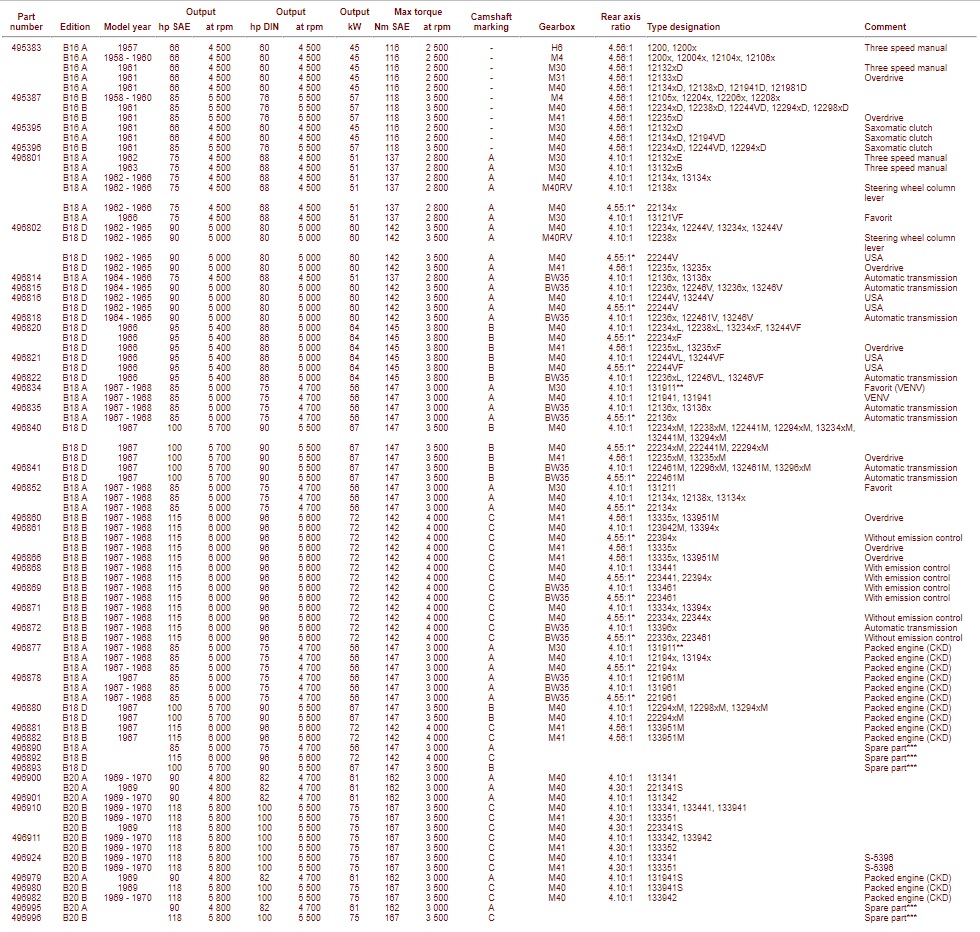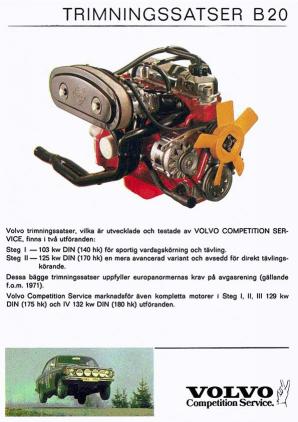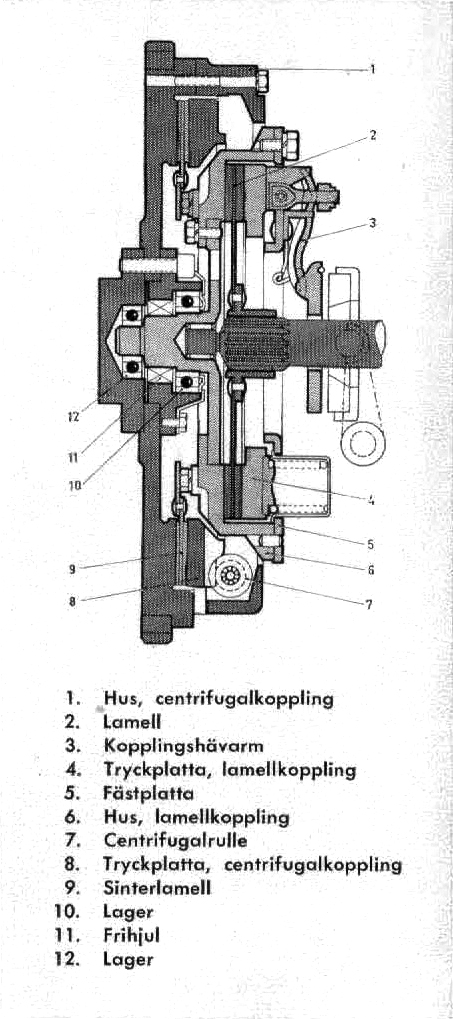Starting with the PV 444, Volvo introduced a new generation of four cylindered engines that up until only a few years ago were the very heart and soul of Volvo cars. Countless engines have driven Sweden’s car park through the years, but few have been as robust and reliable as Volvo’s cast iron engines B16, B18 and B20 (also B14, B21 and B23) which all were based on the B4 engine from 1944. Volvo Amazon was introduced in 1956 with the B16 A as only alternative but came through the years to include also the B18 A and B20 A in the standard edition (121) and the B16 B, B18 B, B18 D and B20 B in its sport editions (122 S and 123 GT).
Sections:
Engines
Outputs
Trim Kits
Other Engines
Carburetors
Gearboxes
Rear Axles
Distributors
Engines
When Volvo Amazon is introduced the new B16 A engine is the only engine option. The B16 A is essentially a bored B4 B (from 75 mm to 79,37 mm) with a new cylinder volume of 1 583 cm3. The engine output is 60 hp (DIN) / 66 hp (SAE) at 4 500 rpm and the compression ratio is 7.5:1. The Zenith carburetor is bigger than on the B4 B and B16 A also has a direct oil filter. The sport engine B16 B is introduced in the spring of 1958 and Volvo states the output to 76 hp (DIN) / 85 hp (SAE) at 5 500 rpm (more accurate is 88-89 hp (SAE) at the same rpm). This is achieved by dual SU H 4 carburetors, different cam shaft, lead-bronze bearings, different inlet valves and valve springs. Up until 1958, Volvo primarily stated the effect in their engines in accordance with the DIN standard but when Amazon Sport, which initially is intended only for export, is introduced in March 1958 the effect in the then completely new B16 B-engine is stated in accordance with the more optimistic SAE standard. The result of this is that official figures from Volvo for the Amazon (60 hp) is according to the DIN standard and for the Amazon Sport (85 hp) is according to the SAE standard. The difference looks bigger (25 hp) than what it actually is (16 hp). Amazon Sport was sold also in Sweden from September 1958. The B16 engines are found on Volvo Amazon model years 1957 – 1961.
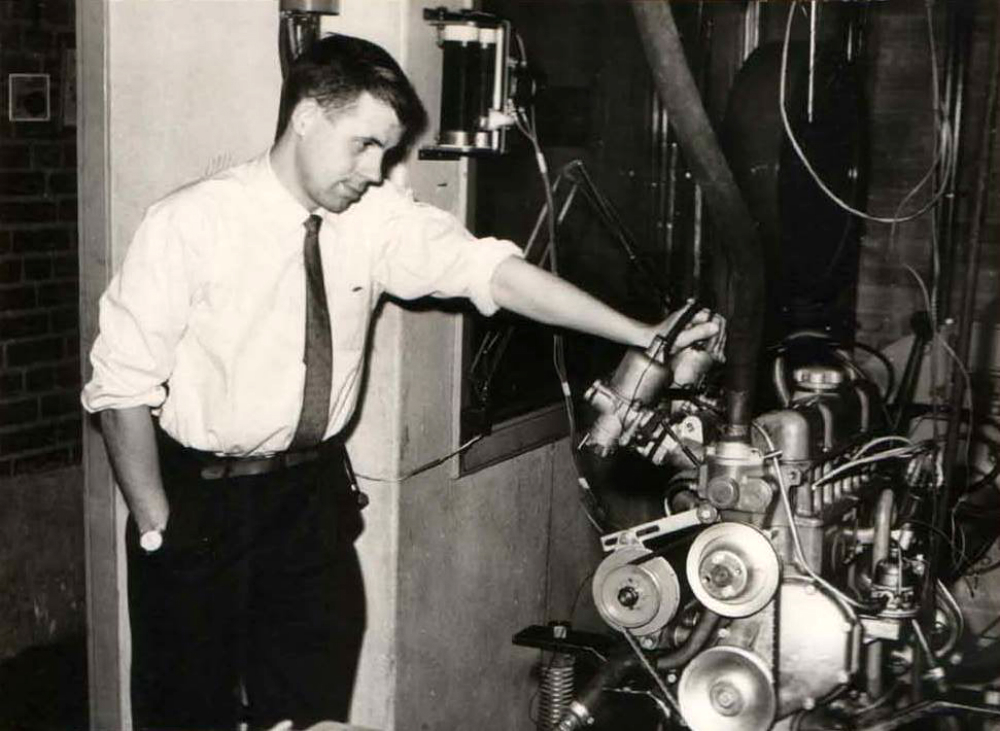
When the B18 engine is introduced in May 1961 on the sports car P 1800 (on the Amazon with model year 1962) it is essentially a completely new engine, designed by later legendary engineer Per Gillbrand. According to the history, the new B18 engine has only one single distance washer in common with the B16 engine, although the fundamental construction is of course the same. The cylinder head has a different shape and each cylinder is fed from a separate inlet port (not via common pairs as on the B16). The crank shaft has five bearings compared to only three before and the cylinder dimension is 84.14 x 80 mm which gives a cylinder volume of 1 780 cm3. The B18 A is armed with a Zenith carburetor which gives an output of 68 hp (DIN) / 75 hp (SAE) at 4 500 rpm, after output increases in 1967 75 hp (DIN) / 85 hp (SAE). The sport engine B18 D is armed with dual SU HS 6 carburetors and has an initial (1962 – 1965) output of 80 hp (DIN) / 90 hp (SAE) and after output increases in 1966 86 hp (DIN) / 95 hp (SAE) and in 1967 90 hp (DIN) / 100 hp (SAE). From now on Volvo states the effect in their engines in accordance with the SAE standard, and still do. The B18 B engine is reserved for P 1800 but comes to the Volvo Amazon in 1967 on the 123 GT edition and on some markets also on the 122 S edition (from 1968 on all 122 S). The B18 B on the Amazon comes without oil cooler and has an output of 96 hp (DIN) /115 hp (SAE). B18 B in the Amazon is identical with the B18 B in the P 1800 when it comes to compression, cam shaft and carburetors during the same model year. The output is different on these cars which, according to the workshop manuals, is due to differences in the exhaust systems. The B18 engines are found on the Volvo Amazon model years 1962 – 1968.
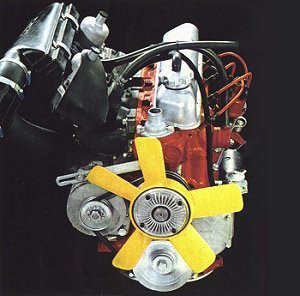
The new B20 engine is introduced also on the Volvo Amazon in August 1968 (for model year 1969). It is a development of the B18 engine that includes bigger cylinder diameter and a cylinder volume of 1 986 cm3. Zenith-Stromberg carburetors on the B20 A and dual SU HS 6 carburetors (dual Zenith-Stromberg on some markets) on the B20 B gives an output of 82 hp (DIN) / 90 hp (SAE) and 100 hp (DIN) / 118 hp (SAE) respectively. The compression ratios are 8.7:1 for the B20 A and 9.5:1 for the B20 B, the differences being achieved by different thicknesses of the cylinder top gaskets. The big difference compared with the B18 engine is not the output but the significantly better torque. The B20 engines are found on the last two model years of the Volvo Amazon, 1969 – 1970.
Outputs
Engine outputs are presented in official Volvo figures, showing both the DIN (Deutsches Institut für Normung) and the more optimistic SAE (Society of Automotive Engineers) values in number of horse powers. Output is measured in Watts, where one horsepower (DIN) equals 746 Watts. In other words, the engine output in Volvo Amazon has varied between 45kW and 75kW. Changes and differences in engine output between different editions (A, B, D) of the same engine has almost exclusively been achieved by Volvo through different carburetors, cam shafts and cylinder head gasket thicknesses.
The table is a complete record of the engines that were factory installed in the Volvo Amazon and is listed after the engine part number. Also listed are torque, camshaft marking, gearbox and rear axis gear ratio. An x is used in the table to indicate that the type designation in question is valid for both LHD and RHD. For model years 1957 – 1966 x is V for LHD and H for RHD. V represents Vänster, the Swedish word for left and H represents Höger, the Swedish word for right. For model years 1967 – 1970 x is 1 for LHD and 2 for RHD.
* Please refer to the section on rear axles below regarding the 4.55:1 ratio.
** 131911 refers to Volvo Amazon Favorit assembled abroad.
*** Spare part engines are delivered without flywheel casing, flywheel, thermostat, water pipes, manifolds, fuel pump, starter motor, distributor, generator and crankcase ventilation.
The sport engine B18 D is equipped with two-bolted dual SU HS 6 carburetors, induction manifold in aluminum and separate exhaust manifold with single outlet during the model years 1962 – 1966. This concerns then the engines with part numbers 496802, 496815, 496816, 496818, 496820, 496821 and 496822. With model year 1967 the B18 D, just as B18 B, get three-bolted dual SU HS 6 carburetors, combined cast iron induction and exhaust manifold with dual outlets. The B18 D is phased out during model year 1967 and is replaced by the B18 B. On model year 1967, the B18 B is found on all 123 GT, on some 122 S in export edition for the USA, on some CKD cars for South Africa and on cars delivered to the Swedish police. From model year 1968 the B18 B is used on all 122 S and 123 GT, but 1968 is also the last model year for the B18 engine.
Trim Kits
Volvo was very successful on the international competition scene in the early and mid 1960s. Gunnar Andersson, successful Swedish rally driver, was convinced in 1962 by Volvo CEO Gunnar Engellau to head Volvo’s new Competition Service department. This was no easy decision for Andersson who was at the peak of his career with a European Rally Champion title, but was made somewhat easier when Engellau pointed out that Andersson at Volvo would be working full time with what had been his private hobby for several years. Volvo built a series of 1,000 Volvo 122 S that were very capable for sport and competition use. Some 800 units were built in Gothenburg and the remaining 200 units were finished at assembly plants abroad. The competition version of the 122 S quickly became both popular and competitive, and was very appreciated among rally drivers. This was the reason why Volvo started selling a trim kit for Volvo Amazon also directly to customers. The cars that left Volvo Competition Service with theses special trim kits were often referred to as Rally Sport or R edition by the customers, a name and a feature that Volvo use still today.
Competition regulations required that at least 1,000 units per year were completed as competition vehicles. Volvo Competition Service was located to Jannesson’s smithy (a smaller forge shop of around 3,200 ft² that came with the property that Volvo purchased near Torslanda in November 1959) and at most Volvo delivered 30 – 50 cars a day there. The cars – all 122 S – were taken finished off the assembly line, were driven to the smithy and got the parts that were included in the trim kit replaced. Some 8 – 10 people worked at Volvo Competition Service at the time and there was room in the smithy for five or six cars. The competition cars were more or less only modified mechanically. No badges were added or replaced, but a tachometer was added to the dash. Editions that were not sold to the public in Sweden until several years later, such as P 130 in 122 S edition, left Jannesson’s smithy for Swedish rally teams already in 1962 (and then with 115 hp SAE compared to the standard 90 hp SAE of the 122 S). Trying carefully to balance their reputation as a market leader in terms of safety with the goals of strengthening their position on the international rally scene, Volvo did not market the trim kits to the public to any larger extent but kept their resellers informed to give interested customers special information.

An estimated total of 4,000 – 5,000 cars were equipped with trim kits from Volvo Competition Service. The trim kits had part number 419398 and contained the following (major) parts:
- Leveled cylinder head with reduced combustion chamber (compression 11.1:1)
- Bigger inlet valves (1.65 ” compared to the previous 1.57 ”)
- Bigger valve springs
- Bigger washers for the valve springs
- Thinner cylinder head gasket
- More powerful camshaft
- Lighter flywheel (17.6 lbs instead of 25.4 lbs)
- More powerful ignition coil
- Different needles for the SU-carburetors
- Special manifold
- More powerful springs for the clutch
- Oil cooler
These modifications would give the car an output of approximately 124 hp (DIN) / 135 hp (SAE). Later editions of the Volvo trim kits would allow outputs up to 180 hp (SAE). These included specially made cylinder heads, valve sizes of up to 1.81 ” and revolutions of up to 8,500 rpm. It was not only the engines that differed from the original cars – the suspension could also be modified upon request. Volvo had, for instance, cars that were to be sold on markets with poor road conditions (for instance Africa) rebuilt and equipped them with progressive suspension (”Safari suspension”) and also replaced the regular shock absorbers with gas absorbers. Gunnar Andersson retired from Volvo in the summer of 1983.
Other Engines
The rumors that circulated around the time of the introduction of the Volvo Amazon that it would come with other, bigger engines than those in the predecessor Volvo PV (see the section on history) such as a straight six or even a V8 turn out to be not entirely rumors.
Already in the spring of 1957 Volvo is working on a prototype based on a smaller V8 of around 90 hp SAE. The engine was designed by Volvo, more specifically by Gunnar Nordin, for a later abandoned project in the mid 1950s called ”Victor”. Nordin based the new engine on the B8B engine he had previously designed for the perhaps more well known project ”Philip” in the early 1950s and provided this new engine with a smaller cylinder volume, around 2.5 liters compared to the 3.5 liters in the B8B. Nordin’s new V8 is labeled C8B, is manufactured in Volvo’s engine factory in Skövde and is designed to fit both in Volvo’s line of trucks as well as in their car programs but according to Volvo there was only five engines built, all of them with slightly different cylinder volume. These C8Bs came out as entirely different from the B8B.
Volvo took the decision to try out one Volvo Amazon with a V8 engine and went for the C8B from the mentioned project ”Victor”. A garage is rented behind Lundby’s old church just outside Volvo’s factory premises and the new project is located there. To get the C8B to fit in the engine bay of an Amazon it turns out that the car needs to we widened with approximately 4.70″ and a prototype based on two Amazon cars is built during the period May through September 1957. The body is built by none less than chief foreman and Volvo legend Axel Roos by a widening of 2.35″ in each direction, so that the first of the two standard Amazons is cut in half 2.35″ to the right of its center line and the other 2.35″ to the left upon which the two parts are welded together to one body. The prototype keeps the same wheel base as the standard car but the suspension is adjusted somewhat for a smoother ride.
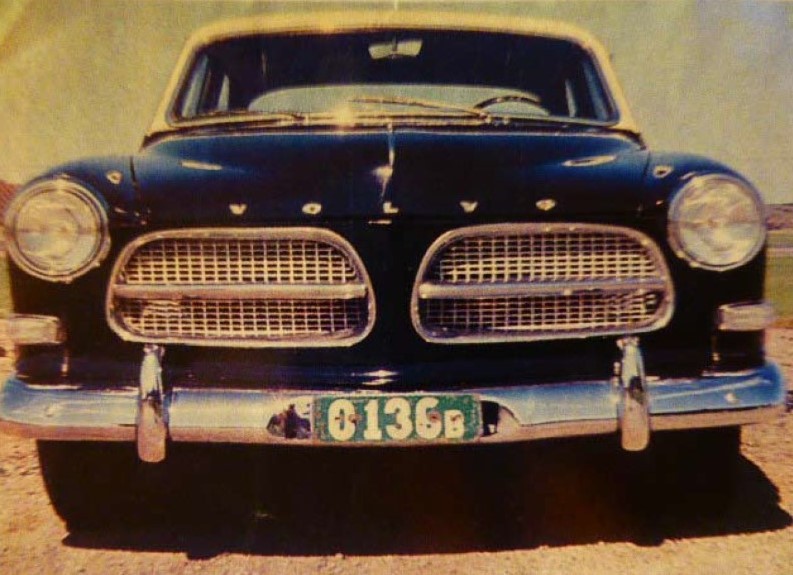
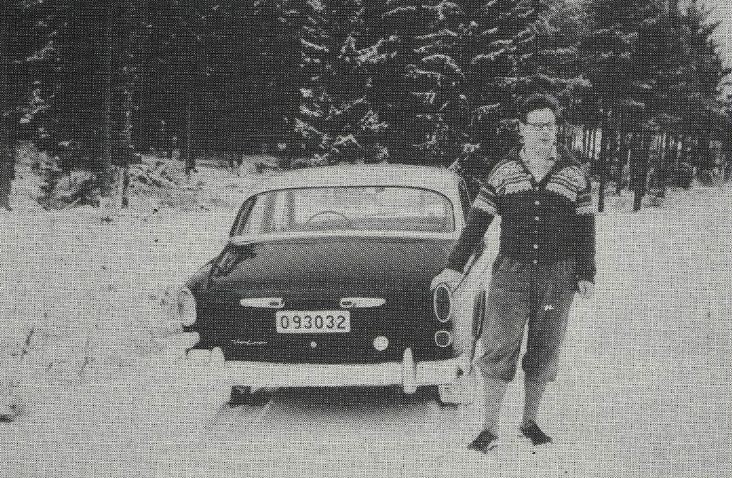
The car is black with grey beige roof and looked despite its much bigger width quite normal. Ove Nilsson participated in the project and later used the car daily as his company car for about a year during which he drove 6 800 miles with it without anyone seeming to notice anything different. With 12V electric system the car had different electric components compared to the standard Amazon but the interior, with bench type front seat, was more similar. The gearbox was a fully synchronized three step Borg-Warner tranny with electric overdrive and steering wheel lever. The prototype, called Brede (Swedish for The Wide One) gets the type designation P5570 and chassis number X1. It was approved with a weight of 2 800 lbs and was registered for traffic with license O93032 on September 3rd, 1957. Brede was owned by AB Volvo all the way up until it was scrapped on March 11th, 1961.
Earlier, before the project with Brede, the respected magazine Racing writes an article in the fall of 1956 about Volvo’s plans of a V8 engine that will also fit its passenger cars. They assume it will be Volvo’s engine B36AV, which also is a development of the B8B but that is much bigger than the C8B, and speculate of an output of 120 hp SAE and speeds in excess of 125 mph in the Amazon. But the only Amazon prototype ever built with a V8 engine is Brede and Volvo later decides to close the project. As a result there was only one Amazon ever built with a V8 engine and here that story ends.
As for a straight six engine, that never materialized in the Volvo Amazon. The six cylinder B30 engine that Volvo later developed out of the B20 and used in Volvo 164 didn’t fit well in the Amazon, even though several Amazon owners later managed to do just that, plus around this time the Amazon era was about over.
Sources include:
* C. Larsson, ”Amazon ’Brede'”. Amazonbladet #1 1986 and #1 1987.
* ”Volvo-bomb kommer efter nyåret”. Racing, Oct 31st, 1956.
Carburetors
The carburetor armament in Volvo Amazon has varied during the years, but the cars were consistently delivered with single carburetor setup on the A engines and dual carburetor setup on the B and D engines. The brands were with few exceptions Zenith and Zenith-Stromberg respectively on the A engines and Skinners Union (SU) on the B and D engines. On some markets the B20 A engine was fitted with one SU HS 6 carburetor, but this may have concerned only the 140-series. On some markets (North America) the B20 B engine was fitted with dual Zenith-Stromberg carburetors, as on the P 1800.
The choice of SU carburetors on the performance engines was made already before the Amazon Sport came in 1958. When Volvo first worked on increasing the output in the B4 B engine for the PV 444 it was quickly concluded that the single carburetor from Zenith-Stromberg was not enough. According to the stories, one of the employees in the construction department owned an MG which was fitted with two SU carburetors. After some brief studies of these Volvo also thought that these were a good choice of carburetors for engines with more power. Volvo’s performance version of B4 B was called B14 A and can be found on the Volvo Sport (P 1900) and on the PV 444 in export edition for North America, with dual SU H 2 carburetors which have an air intake of 1¼”. H stands for Horizontal and 2 stands for two eights larger than one inch (i.e. ¼”). British logic.
When Volvo’s next performance engine B16 B is introduced with the Amazon Sport in February 1958 it is fitted with dual SU H 4 carburetors, which then has an intake of 1½”. B16 B leads to several successes on the rally and racing scenes for Volvo with PV 444 and later PV 544, and when the export of Amazon to North America starts during 1959 these cars are equipped with this engine. During 1961 Per Gillbrand’s new B18 engine is introduced and its performance version B18 B is found in the Volvo Sport successor P 1800 with dual SU HS 6 (intake 1¾”). S represents a cold start function. B18 B is later introduced also on the Amazon but not until model year 1967 on the 122 S and on the 123 GT.
| Carburetor | Number | Engine | Model Year | Edition | Body |
| Zenith 34 VN | 1 | B16 A | 1957 – 1961 | Amazon (121 from 1958) | P 120 |
| SU H 4 | 2 | B16 B | 1958 – 1961 | Amazon Sport (122 S from 1958) | P 120 |
| Zenith 36 VN | 1 | B18 A | 1962 – 1966 | 121 | P 120, P 130, P 220 |
| Zenith-Stromberg 175 CD / CD-2S * | 1 | B18 A | 1967 – 1968 | 121 | P 120, P 130 |
| SU HS 6 (two-bolted) | 2 | B18 D | 1962 – 1966 | 122 S | P 120, P 130, P 220 |
| SU HS 6 (three-bolted) | 2 | B18 D | 1967 | 122 S | P 120, P 130, P 220 |
| 2 | B18 B | 1967 – 1968 | 122 S, 123 GT | P 120, P 130, P 220 | |
| Zenith-Stromberg 175 CD-2 | 1 | B20 A | 1969 | 121 | P 130, P 220 |
| Zenith-Stromberg 175 CD-2SE | 1 | B20 A | 1970 | 121 | P 130 |
| SU HS 6 ** | 2 | B20 B | 1969 – 1970 | 122 S, 123 GT | P 130, P 220 |
* Zenith-Stromberg 175 CD on early editions, Zenith-Stromberg 175 CD-2S on late editions (not related to markets).
** Zenith-Stromberg 175 CD-2 and CD-2SE on cars sold in the USA and Canada. Both markets are mentioned in the B20 spare parts catalogue.
Gearboxes
In the beginning the Volvo Amazon inherits a lot of its mechanics from the predecessor PV 444 and this includes the gearbox, which for the first model year is a three gear transmission labeled H6 with unsynchronized first and with reverse gear. The H is an indication of how the gears are placed inside the gearbox and unsynchronized first means that the driver has to step on the clutch twice in order to put in the first gear. Already when introduced, there are complaints about the missing fourth gear. The Amazon is priced 25% higher than a PV and with that comes expectations, expectations that the H6 box simply could not meet. Volvo probably sat on an overstock of H6 boxes and felt a need to reduce this stock to a more acceptable level and hence used the same box also in the Amazon. In February 1958 the first Amazons with the new and fully synchronized four geared gearbox are produced. It is initially labeled M3 but this is changed just in time for the introduction (but some shop literature had already been printed with references to M3). M stands for manual and 4 indicate the number of gears. The M4 is fitted in both Volvo Amazon and Volvo Amazon Sport. The M4 was developed and used as base for the major transmission changes that came with model year 1961, when gearboxes M30, M31, M40 and M41 replaced the M4. The three first were available on the standard edition while the two latter were available on the sport edition, with a few exceptions (see below). The first digit states the number of gears (three or four) while the last digit state overdrive (1) or not (0). The body was adjusted on model year 1961 cars to fit the new gearboxes, which are bigger than the predecessors, and consequently it is not possible to retrofit them on earlier model years without rebuilding the tunnel. Minor changes were also done on the engine (B16 A and B16 B) and its crankshaft and flywheel housing and the new boxes will not retrofit on earlier versions of the engine without these changes being made.
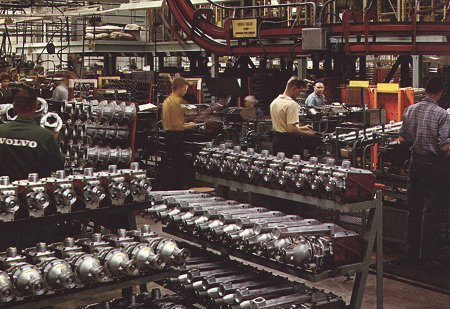
Especially the M40 was developed much during the Volvo Amazon era and is found under several different part numbers. The M31 disappeared after only one model year (1961) and is found on 1 120 Volvo Amazons (mostly either slate blue or black) up to and including ch.-no. 80258. Also the M30 was only available for a short time (1961 – 1963 and later on the Volvo Amazon Favorit 1966 – 1968). It is obvious that most customers preferred four or more gears and both the M30 and the M31 are quite rare today. Gearbox swaps to M40 or M41 are probably two of the most common and most popular changes among Amazon owners.
In total, we find the following gearboxes factory installed on the Amazon series:
| Gearbox | Type | Model year | Engine | Edition |
| H6 | Three speed manual transmission with reverse and unsynchronized first | 1957 | B16 A | Amazon |
| M4 * | Four speed fully synchronized manual transmission | 1958 – 1960 | B16 A, B16 B | Amazon, Amazon Sport (121, 122 S) |
| M30 | Three speed manual transmission | 1961 – 1963 | B16 A, B18 A | 121 |
| 1966 – 1968 | B18 A | Favorit | ||
| M31 | Three speed manual transmission with overdrive | 1961 | B16 A | 121 ** |
| M40 *** | Four speed manual transmission | 1961 – 1970 | B16 A, B16 B, B18 A, B18 D, B18 B, B20 A, B20 B | 121, 122 S |
| M41 Type D | Four speed manual transmission with overdrive | 1961 – 1968 | B16 B, B18 D, B18 B | 122 S ****, 123 GT |
| M41 Type J | Four speed manual transmission with overdrive | 1969 – 1970 | B20 B | 123 GT |
| BW35 | Three step automatic transmission with steering wheel lever | 1964 – 1968 | B18 A, B18 D, B18 B | 121, 122 S |
* The M4 was called M3 during early development and some shop literature had already been printed when the name was changed.
** The M31 is found as option only on the 121 and only in 1961; examples include chassis numbers 61167 and 67458.
*** Sometimes called M40GV where GV stands for floor lever. Also available with steering wheel lever on P 120 cars as M40RV.
**** The M41 is available as option on the 122 S until 1966, from 1967 exclusively on the 123 GT. Not on cars sold in the USA. Together with B16 B only late 1961 cars.
These gearboxes have the following ratios per gear:
| Gearbox | First | Second | Third | Fourth | Overdrive | Reverse | Comment |
| H6 | 3.13:1 | 1.62:1 | 1:1 | 2.66:1 | |||
| M4 | 3.45:1 | 2.18:1 | 1.31:1 | 1:1 | 3.55:1 | ||
| M30 | 3.13:1 | 1.55:1 | 1:1 | 3.25:1 | |||
| M31 * | 3.13:1 | 1.55:1 | 1:1 | 0.756:1 | 3.25:1 | ||
| M40 (B16, B18) ** | 3.13:1 | 1.99:1 | 1.359:1 | 1:1 | 3.25:1 | 1961 – 1968 | |
| M40 (B20) | 3.13:1 | 1.99:1 | 1.362:1 | 1:1 | 3.25:1 | 1969 – 1970 | |
| M41 Type D | 3.13:1 | 1.99:1 | 1.359:1 | 1:1 | 0.756:1 | 3.25:1 | |
| M41 Type J | 3.13:1 | 1.99:1 | 1.362:1 | 1:1 | 0.797:1 | 3.25:1 | |
| BW35 | 2.39:1 | 1.45:1 | 1:1 | 2.09:1 |
* The M31 has overdrive on both second and third gears and is, in principle, equipped with five gears. The second gear with overdrive has the ratio 1.17:1 (= 1.55 * 0.756).
** Includes steering wheel lever M40RV (only on P 120).
M40G is a variant of M40 that includes a bigger flywheel companion (part number 380606, which is also available for the M30) to reduce vibrations. It is introduced on the P 220 during model year 1967 from ch.-no. 53957 and on the P 130 during model year 1968 from ch.-no. 296543 on cars with the M30 (i.e. Favorit) and from ch.-no. 296129 on cars with M40 (i.e. 121 and 122 S).
All gearboxes are listed below per part number. Please note that not all combinations were available on all markets.
| Gearbox | Part number | Engine | Model year | Gearbox type | Body / Edition |
| H6 | 254122 | B16 A | 1957 | Floor lever | P 1200 |
| M4 | 254161 | B16 A, B16 B | 1958 – 1960 | Floor lever | P 120 (121, 122 S) |
| M30 | 254200 | B16 A | 1961 | Floor lever | P 120 (121) |
| 254240 | B16 A | 1961 | Floor lever and Saxomat | P 120 (121) | |
| 254248 | B16 A | 1961 | Steering wheel lever and Saxomat | P 120 (121) | |
| 254308 | B18 A | 1962 | Floor lever | P 120 (121) | |
| B18 A | 1963 | Floor lever | P 130 (121) | ||
| B18 A | 1966 | Floor lever | P 130 (Favorit)* | ||
| 254511 | B18 A | 1967 – 1968 | Floor lever | P 130 (Favorit)* ch.-no. 216950-296542 | |
| 254583 | B18 A | 1968 | Floor lever | P 130 (Favorit)* ch.-no. 296543-312499 | |
| M31 | 254238 | B16 A | 1961 | Floor lever | P 120 (121) |
| M40 | 254306 | B16 A, B16 B | 1961 | Floor lever | P 120 (121, 122 S) |
| 254250 | B18 A, B18 D | 1962 – 1966 | Floor lever | P 120, P 130, P 220 | |
| 254498 | B18 A, B18 D, B18 B | 1967 – 1968 | Floor lever | P 120, P 130 ch.-no. 216950-296128, P 220 ch.-no. 44600-53956 | |
| 254539 | B18 A, B18 D, B18 B | 1967 – 1968 | Floor lever | P 130 ch.-no. 296129-312499, P 220 ch.-no. 53957-70299 | |
| 254580 | B20 A, B20 B | 1969 – 1970 | Floor lever | P 130, P 220 | |
| M40RV | 254307 | B16 A, B16 B | 1961 | Steering wheel lever | P 120 |
| B18 A, B18 D | 1962 – 1966 | Steering wheel lever | P 120 left hand drive | ||
| 254514 | B18 A, B18 D | 1967 | Steering wheel lever | P 120 left hand drive | |
| 254297 | B18 A, B18 D | 1962 – 1963 | Steering wheel lever | P 120 right hand drive ch.-no. 84300-129999 excl. 129901-129903 | |
| 254381 | B18 A, B18 D | 1963 – 1966 | Steering wheel lever | P 120 right hand drive ch.-no. 129901-129903, 130000-225049 | |
| 254515 | B18 A, B18 D | 1967 | Steering wheel lever | P 120 right hand drive | |
| M41 type D | xxxxxx ** | B16 B | 1961 | Floor lever | P 120 (122 S) |
| 254322 | B18 D | 1962 – 1967 | Floor lever | P 120, P 130 (122 S) | |
| B18 B | 1967 – 1968 | Floor lever | P 130 (123 GT) | ||
| M41 type J | 254581 | B20 B | 1969 – 1970 | Floor lever | P 130 (123 GT) |
| BW35 | 254410 | B18 A, B18 D | 1964 – 1966 | Steering wheel lever | P 120, P 130 |
| 254525 | B18 A, B18 D, B18 B | 1967 – 1968 | Steering wheel lever | P 120, P 130, P 220 |
* Volvo Amazon Favorit. Type designation 13121x. Also 13191x (Favorit assembled abroad).
** Part number not known. With adjustments for the B16 engine (including 6V electric system). B18 gearbox does not fit B16.
Overdrive
When driving on highways at constant speed on the fourth gear the full power of the engine is rarely used. When this excess power is not needed for acceleration or climbing hills it can instead be reduced with a separate overdrive unit. This provides a lower engine RPM at the same speed, which has two big advantages: lower engine sound and lower fuel consumption. The overdrive is comfortably operated with a lever mounted on the steering wheel column. Engaging and disengaging is done fast and easy, according to Volvo without having to use the clutch. It has, however, been established later that gearboxes with overdrive units that are engaged/disengaged using the clutch last a lot longer.
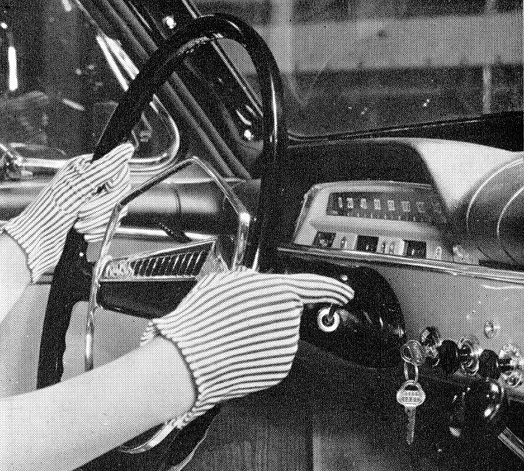
Overdrive came with the new gearboxes M31 and M41 in 1961 and are found in combination with the B16 engine and 6V electric system only that model year *. Overdrive is like a fifth gear, and is so adjusted that it is ideal for driving in high speeds on flat roads (in other words, it is not designed for acceleration). The overdrive units for M31 and M41 were manufactured by Laycock de Normanville and are a smaller and separate gearbox fitted behind the regular gearbox, i.e. on the outgoing shaft from the gearbox on the propeller shaft. The overdrive is locked to the second and third gears on the M31 and to the fourth gear on the M41 using an electric breaker switch on the gearbox lid, and is not an ordinary gear controlled by the gear shift lever but toggled by an electric switch. On the Volvo Amazon, this switch is located on the steering wheel pole cover on the opposite side to the turn signal switch (the switch also has an identical design as the turn signal switch). A red indicator light placed on the instrument panel between and above the lighter and the fan knob indicates the position of the switch (on or off). The electric switch on the gearbox lid prevents the overdrive unit from being engaged on other gears than what it can handle – the torque will be too high on low gears and the overdrive unit would break completely should it be engaged together with the reverse gear.
The overdrive units were of Type D model years 1961 – 1968 (in combination with the B18 engine) and of Type J in 1969 – 1970 (with the B20 engine). Type J is a more robust and reliable construction while Type D has a higher RPM reduction (0.756:1 or approximately 24 % compared to 0.797:1 or approximately 20 % for the Type J). Type J also comes with an improved hydraulic system that provides smoother kick in/out and is less sensitive to pollution thanks to an added fine particle filter in the pressure line. Volvo wired the Type D via a relay in the engine compartment while Type J was wired directly to +12 VDC (after the 25 A fuse), but both types can be wired either way. One distinction between Type D from Type J from the outside is that the solenoid is placed on the left side on the Type J and on the right side on Type D.
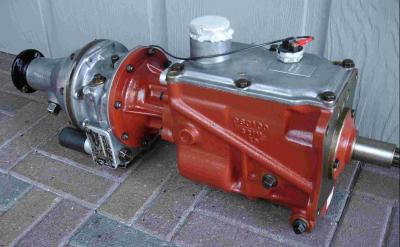
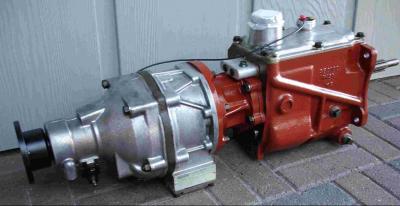
On cars with overdrive Volvo choses a rear axle with the ratio 4.56:1 compared to 4.10:1 on cars without overdrive. This provides extra pull during acceleration with the overdrive disengaged. When the B20 engine is introduced with model year 1969 the rear axle ratio is changed to 4.30:1 on cars with overdrive.
Overdrive was an option on the Amazon 121 model year 1961 (M31) and on 122 S model year 1961 – 1966 (M41) with some exceptions. Overdrive was not available on all markets and can not be found on export cars to the USA, and also not on all bodies (not on the Estate, P 220). M41 with overdrive in combination with the B16 B engine came late in the model year 1961 and only on 199 cars, between ch.-no. 80683 and 82239. From model year 1967 overdrive is only available on the 123 GT but then as standard equipment. Overdrive was also standard on the 1800 S and on Volvo 144 with B18 B.
The Laycock de Normanville Type J overdrive unit is found on M41 and M46 on about two decades of Volvo cars and is a significantly stronger construction than the earlier Type D, but the gearbox itself still has the same flaws as earlier M40 and M41 boxes.
* Volvo 122 S / Volvo Amazon Sport with overdrive (B16 B + M41, 12235V/HD), for instance ch.-no. 80701, 80756, 81361 and 81362.
Automatic
Many of Volvo’s customers in North America asked for automatic transmission but it isn’t until model year 1964, in August of 1963, that Volvo is able to deliver this as an option on the Volvo Amazon. This automatic gearbox is suitably manufactured by the American company Borg-Warner, is named BW35 and is a three step automatic tranny notorious for the high fuel consumption it causes. The BW35 is initially only available on Amazons with the four door body (P 120) but is later also made available on the two door (P 130) with model year 1965 and on the Estate (P 220) with model year 1967. In Sweden and on some other markets it is sold on cars with the special edition (121) with the A engine, but fact is that the BW35 works a lot better together with the B and D engines. Cars with automatic transmission are fitted with a special ”Automatic” badge on the trunk lid. The last model year with automatic transmission on the Volvo Amazon is 1968.
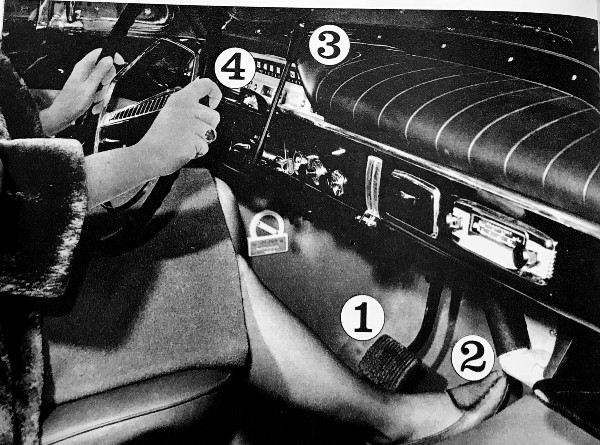
Amazon Automatic has only two pedals: brake pedal (1) and gas pedal (2). On the steering wheel column is a ”drive selector” (3) and a gear indicator housing (4). This is the wording in the caption to the image above in Volvo’s customer magazine Ratten. Let’s continue tapping in on how Volvo presented the news of the automatic transmission in Volvo Amazon:
”Long queues of cars, moving only a few feet at a time, constant stops and starts at traffic lights, repeated attempts at agreeing on parking spaces, which all seem to have in common that they are as narrow as they are rare – we all recognize the picture.
The annoyances of big city traffic has surely contributed to the construction of the automatic gearboxes. These are also on a strong advance throughout the world. In the leading country USA it is estimated that 75 percent of all passenger cars sold will be equipped with automatic gearboxes. In Sweden, Volvo has during the fall of 1963 introduced a model with automatic transmission in Volvo Amazon Automatic – i.e. a 4 door 75 hp Volvo Amazon with Borg-Warner automatic gearbox.
Accepting the challenges of big city traffic in an Amazon Automatic gives the following experiences, among others:
- The disengagement step with the clutch has disappeared.
- Only when starting and backing up does the driver with an easy hand have to use the drive selector.
- You can sit in traffic without having to handle more than the steering wheel, gas pedal and possibly brake pedal. The gears are managed automatically by the gearbox.
- Shortly put: Driving becomes easier – and more comfortable.
Also when driving on open roads, the characteristics of the Automatic are noticeable. If you for instance want to accelerate during an overtaking, you do a so called kick down (a quick and firm step on the gas pedal). If you are driving in third gear the gearbox will then automatically shift down to second gear for faster acceleration and it is easy to complete the overtaking.
Let’s take a closer look at the Amazon Automatic. On the exterior it doesn’t look any different than a regular Amazon, except for the ’Automatic’ badge on the trunk lid. Inside the car you first notice that two things are missing: the clutch pedal and the gearshift lever.
A drive selector and a gear indicator – both placed on the steering column – have been added and the brake pedal is wider.
How do you drive a Volvo Amazon Automatic? Nothing could be simpler. Here’s a quick lesson:
- Start the engine. Put the drive selector in Drive position. Press the gas pedal and the car will accelerate and the gear shifting throughout the register will happen automatically.
- You a approach a traffic situation or a traffic light, where you need to keep the car running and ready. Release the gas pedal and the car will slow down to slow speed. An easy press on the brake pedal will make it stop completely – with the engine running. When you want to proceed, just release the brake pedal and give gas.
- When you park the car, put the drive selector in Park position.
A small detail worth mentioning is that no oil changes are necessary in the automatic gearbox. Checking on oil level at as long intervals as 3 000 miles is the only care it needs.
A distinct advantage with the Amazon Automatic is that the driver is given better opportunity to concentrate on the traffic. Many of the problems that can occur when it is important to combine and use the pedals, steering wheel, gearshift lever and controls in the right way are eliminated. All drivers get a comfortable driving experience and particular advantages are of course given to many of our handicapped. Not least from that perspective the Automatic is a nice complement to the other cars in the Amazon series.”
Saxomatic Clutch
Automatic clutch of the type Saxomat, a.k.a. saxomatic clutch, is available as option for 121 (B16 A) model year 1961 only in combination with the gearbox M30. Saxomatic clutch is available in combination with both floor lever and steering wheel lever, and is found also on the PV 544.
Cars with saxomatic clutch do not have a clutch pedal. Instead the clutch is controlled by a servo cylinder connected to the clutch (see illustration to the right). Engagement and disengagement is done via an electric impulse from a switch in the gear shift lever. The engine is disengaged as long as the gear shift lever is touched.
Saxomatic clutch does not affect the gear ratios.
When starting the engine in a car with saxomatic clutch the gear shift lever needs to be in neutral. With the engine running at idle, the desired gear is engaged and then some gas is given upon which the car will move. When shifting up, ease the accelerator and move the gear shift lever to the desired position. Release the gear shift lever and give more gas with the accelerator. When shifting down during acceleration, keep the accelerator in an unchanged position and quickly move the gear shift lever to the lower gear. When shifting down during deceleration, release the accelerator and thereafter put the gear shift lever in the lower gear. The car can be brought to a full stop without having to touch the gear shift lever. Before the engine is stopped, the gear shift lever should be moved to neutral. It is important never to touch the gear shift lever except when shifting gears and to always release the gear shift lever as soon as this has been completed.
Cars with saxomatic clutch has a different part number of the engine with differences in both the cooling system, with a different thermostat casing and different thermostat (205° vs the normal 195°), as well as in the electric system with a different type of generator (that also later came in the other cars) and different type of temperature gauge. Naturally also in the gearbox. There are also smaller differences in the heater system, on the carburetors and in the brake system.
Rear Axles
This section exist thanks to a lot of contribution from Lars Björklund. The two splines in the drive unit called pinion and crown wheel define the ratio on a rear axle. The number of splines on pinion and crown wheel and their relation to each other defines the ratio. Take for example the ratio 4.10:1 in which the entering axle (pinion with the propeller shaft) has 10 splines and the exiting axle (crown wheel with drive shaft and rear wheels) has 41 splines. The pinion will then rotate 41/10 (=4.1) times for every round the wheels rotate.
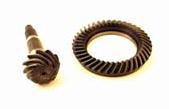
Both the rear axles and their ratios have varied with model years and editions. The rear axle ratios found on Volvo Amazon are 4.56:1, 4.55:1, 4.30:1 and 4.10:1*. The first model years, with the B16 engine (1957 – 1961), have rear axles from ENV and Spicer (model 23) with the ratio 4.56:1. The cars were randomly fitted with rear axles of both brands without any apparent order, although the spare parts catalogue lists what chassis numbers got what axle. Some time into model year 1961 the Spicer M23 is replaced with the new M27. This happens at ch.-no. 61891 (after testing on ch.-no. 57679). M27 is distinguishable from its predecessor in that it lacks the oil drain plug (the oil is instead changed through the inspection hole).
With the B18 engine (1962) the ratio is changed on cars without overdrive (both 121 and 122 S) to 4.10:1* while cars with overdrive (122 S ordered with M41) keeps the ratio 4.56:1. The brands are still ENV* and Spicer (now model 27); again the spare parts catalogue lists what chassis numbers were fitted with what axle. The rear axle mantle is changed on the ENV axis during model year 1964 to fit the drive units from the Spicer axle. The Spicer 27 rear axle (and later Spicer 30) was also manufactured by Canadian company Hayes from late model year 1964, as part of the industrial agreement that Volvo made with the provincial government of Nova Scotia that when establishing an assembly plant there in June 1963 (essentially promising to source a certain share of the parts locally). The American axle and driveshaft manufacturer Spicer Corp. was renamed to Dana Corp. in 1928 when the company relocated from New Jersey to Toledo, Ohio while many of the products kept the name Spicer for several decades. Spicer 27, 30, etc. are in other words identical with Dana 27, 30, etc.
When the Estate (P 220) is introduced during 1962 it comes with a rear axle from Salisbury with the ratio 4.55:1. Later during the manufacturing of the Estate (about 1965) Volvo starts buying rear axle drive units from one additional supplier, and this drive unit has the ratio 4.56:1. Both drive units are kept on stock under the same part number and are mounted randomly in the Salisbury axle latest up to and including model year 1968. The new Spicer 30 is mounted in the Estate during model year 1965 (from ch.-no. 26228) but only comes with the ratio 4.56:1. The practical difference between the ratios 4.55:1 and 4.56:1 is of course limited, and Volvo has different data on what ratio the Estate had 1962 – 1968, for instance several sales brochures state 4.56:1 1962 – 1968 while mechanical shop literature state 4.55:1 1962 – 1967.
The Spicer 30 axle starts replacing the older Spicer 27 on the four door version (P 120) and two door version (P 130) from week 5 1966, still with the ratio 4.56:1 on cars with overdrive (some 122 S 1966 – 1967 and all 123 GT 1967 – 1968) and with 4.10:1 on all others. During model year 1967 (week 48 1966) Volvo starts mounting a their own version of Spicer 30 in the P 130 that they also produce themselves, mixed with Spicer and Hayes manufactured axles. This axle is called Volvo 1030, where 10 indicates Volvo, but is identical to Spicer 30 and Hayes when it comes to parts. The 1030 axle stuck around until the late 1980s on the 240- and 740-series (of course with different suspension and brake equipment). With the model year 1969 the ratio is changed again in the Estate and on the few cars delivered with overdrive 1969 – 1970 (123 GT) when it is reduced to 4.30:1. The other cars keep 4.10:1 to the bitter end.

Simply put: P 120 with the B16 engine (1957 – 1961) has the rear axle ratio 4.56:1. P 120 and P 130 with the B18 engine (1962 – 1968) and overdrive transmission has the ratio 4.56:1 (including the 123 GT). P 120 and P 130 with the B18 or B20 (1962 – 1970) engines that do not have overdrive has the ratio 4.10:1. The few P 130 with the B20 engine and overdrive (only the 123 GT) produced 1969 – 1970 has the ratio 4.30:1. P 220 Estate 1962 – 1964 has the ratio 4.55:1. In 1965 – 1968 it’s mixed 4.55:1 and 4.56:1. The last model year (1969) the P 220 gets the ratio 4.30:1.
Volvo Amazon was available with limited slip differential (”anti-spin”) on the rear axle on all editions, but this was an option that the customer had to pay extra for. Volvo Amazon in Swedish Police edition has limited slip differential on many cars (P 120, P 130 and P 220). The 123 GT came with limited slip differential as standard equipment on some markets (not Sweden). See for instance this specification from a reseller in Canada (concerns 123 GT assembled at the Halifax plant, type designation 133951). Limited slip differential was sold as accessory by Volvo and can be retro-fitted.
* The ENV axle with stated ratio 4.10:1 actually has 45/11 (i.e. 4.09:1) but has been rounded off to 4.10:1 by Volvo. This lacks practical meaning, just like the Salisbury axle’s 4.56:1 or 4.55:1.
** ENV was fitted in the P 120 up to chassis number 182155 (roughly half of model year 1965) and in the P 130 up to chassis number 149917 (early model year 1966).
*** The axles get a more stable attachment on the P 120 and P 130 from model year 1967 that does not fit on earlier model years.
**** P 220 in 122 S edition from model year 1963 (only on some markets, including USA).
Distributors
The distributors used in Volvo Amazon are all manufactured by Bosch, but have varied with different editions of engines.
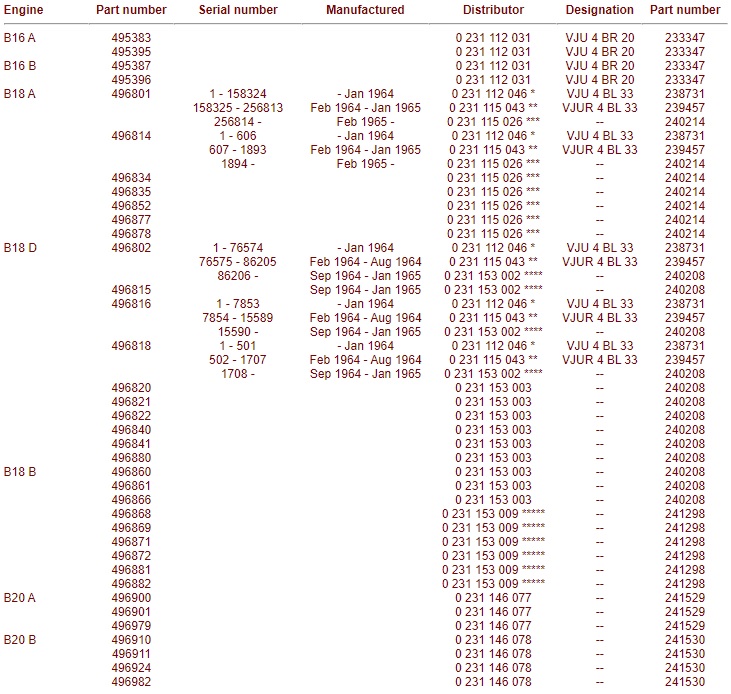
* Replaced by 0 231 115 043.
** Without eccentric screw to adjust breaker gap.
*** With vacuum regulator.
**** With remodeled adjusting mechanism and with radio noise reduction. Replaced by 0 231 153 003.
***** For engines with emission control.
